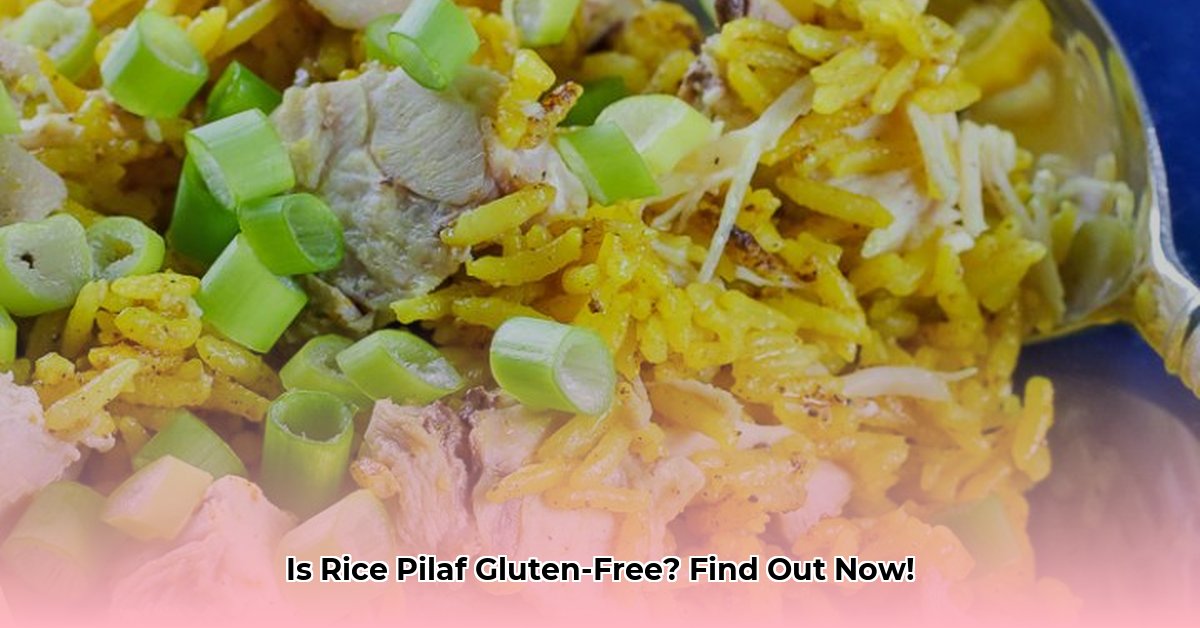Deciphering the Gluten Content of Rice Pilaf
You’re craving rice pilaf, but following a gluten-free diet. Can you indulge? The answer isn’t a simple yes or no. Plain rice is naturally gluten-free, but traditional pilaf often contains hidden gluten. This guide clarifies the confusion, explains why caution is necessary, and provides a step-by-step guide for making a safe and delicious gluten-free version.
Why Traditional Rice Pilaf Might Contain Gluten
While rice itself is gluten-free, traditional recipes often include orzo, a small pasta shaped like rice, typically made from wheat. Wheat, of course, contains gluten. Another potential source of gluten is pre-packaged mixes, which may contain hidden gluten in thickeners or flavor enhancers. Always scrutinize ingredient lists! Cross-contamination can also occur if gluten-containing foods are prepared on the same surfaces as your pilaf.
Crafting a Delicious Gluten-Free Rice Pilaf
Building a gluten-free pilaf is like working with a flexible template. Start with gluten-free rice as your base. Then, customize with safe and flavorful additions like sautéed onions, garlic, herbs, and bell peppers. A rich, gluten-free broth enhances the savory profile. Gluten-free orzo is also available if you crave that classic texture. Remember to choose certified gluten-free broth and orzo to ensure safety.
Worry-Free Recipes: Two Gluten-Free Rice Pilaf Options
Here are two simple, guaranteed gluten-free recipes:
Recipe 1: Hearty Beef-Based Rice Pilaf
This adaptable recipe works with both instant and long-grain rice.
Ingredients:
- 1 tablespoon olive oil
- 1 cup chopped carrots
- 1 cup chopped onion
- 1 cup chopped celery
- 4 cups water
- 2 cubes certified gluten-free beef bouillon
- 2 cups instant white rice (or 1 cup long-grain rice – adjust water and cooking time)
- Salt and pepper to taste
Instructions:
- Sauté carrots, onion, and celery in olive oil over medium heat until softened.
- Add water and bouillon; stir until dissolved and bring to a boil.
- Stir in rice.
- Cover, remove from heat, and let stand (5 minutes for instant rice, 20 minutes for long-grain).
- Fluff with a fork and season with salt and pepper.
Recipe 2: Light and Zesty Mediterranean Rice Pilaf
This recipe emphasizes the natural flavor of the rice with a Mediterranean twist.
Ingredients:
- 1 cup long-grain rice
- 2 cups certified gluten-free chicken broth
- 2 tablespoons olive oil
- 1/2 cup chopped onion
- 2 cloves minced garlic
- Salt and pepper to taste
Instructions:
- Sauté onion in olive oil until translucent, then add garlic and cook until fragrant.
- Add rice and toast lightly.
- Pour in broth, season with salt and pepper.
- Bring to a boil, reduce heat, cover, and simmer for 20 minutes, or until rice is tender.
Navigating the Gluten-Free World
Going gluten-free can be challenging. Key tips include diligently checking ingredient labels, being mindful of cross-contamination, using separate utensils and surfaces, and inquiring about gluten-free options at restaurants. When uncertain, err on the side of caution.
Understanding Gluten: What It Is and Why It Matters
Gluten is a protein found in wheat, barley, and rye, providing bread its chewy texture. However, it can cause severe digestive issues for individuals with celiac disease or gluten sensitivity. Even trace amounts can trigger reactions.
Unmasking Hidden Gluten in Your Food
Common hidden gluten sources in rice pilaf include:
- Broth or Bouillon: May contain wheat-based ingredients. Choose certified gluten-free options or vegetable broth.
- Soy Sauce: Typically contains wheat. Use tamari or coconut aminos as substitutes.
- Seasoning Mixes: Can have hidden gluten. Opt for single spices or create your own blends.
Cross-Contamination: A Sneaky Threat
Even with gluten-free ingredients, cross-contamination can occur. Use dedicated cutting boards, utensils, and cooking surfaces for gluten-free food.
Making Your Own Gluten-Free Rice Pilaf: A Simple Guide
- Start with Gluten-Free Rice: Most rice varieties are naturally gluten-free.
- Choose a Safe Broth: Opt for certified gluten-free or vegetable broth.
- Swap Out Soy Sauce: Use tamari or coconut aminos.
- Season Smartly: Stick to single spices or make your own blends.
- Avoid Cross-Contamination: Dedicate utensils and surfaces for gluten-free cooking.
| Ingredient | Gluten-Free Status | Safe Alternatives |
|---|---|---|
| Rice | Naturally Gluten-Free | Basmati, jasmine, etc. |
| Broth/Bouillon | Often Contains Gluten | Gluten-free versions, vegetable broth |
| Soy Sauce | Often Contains Gluten | Tamari, coconut aminos |
| Seasoning Mixes | May Contain Gluten | Single spices, homemade blends |
Making Gluten-Free Rice Pilaf: A Step-by-Step Guide
The Importance of Gluten Avoidance
For those with celiac disease or gluten sensitivity, even small amounts of gluten can cause significant digestive distress and other health issues. Careful ingredient selection and certified gluten-free products are crucial.
Swapping Out the Orzo: The Key to Gluten-Free Pilaf
Replace orzo with gluten-free alternatives like rice noodles, quinoa noodles, or finely chopped vegetables for a similar texture. Experimentation with other gluten-free pastas is encouraged. Ongoing research may lead to even more gluten-free grain options in the future.
Ingredients for Gluten-Free Rice Pilaf Success
| Ingredient | Quantity | Notes |
|---|---|---|
| Olive oil (or butter) | 1 tablespoon | |
| Small onion | 1, finely chopped | Yellow or white work well |
| Gluten-free orzo substitute | 1 cup | Rice noodles, quinoa noodles, chopped veggies |
| Long-grain rice, rinsed | 1 ½ cups | Rinsing helps remove excess starch. |
| Chicken or vegetable broth | 2 ½ cups | Low sodium is generally preferred. |
| Salt | 1 teaspoon | Adjust to taste. |
| Black pepper | ½ teaspoon | Freshly ground is best. |
| Fresh parsley, chopped | For garnish |
Step-by-Step Instructions:
- Sauté the Onion: Sauté chopped onion in olive oil or butter until softened.
- Toast the Noodles (Optional): Lightly toast rice or quinoa noodles for added flavor. Skip if using vegetables.
- Toast the Rice: Toast rinsed rice for a minute or two, stirring constantly.
- Simmer: Add broth, salt, and pepper. Bring to a boil, reduce heat, cover, and simmer for 18-20 minutes, or until rice is tender and liquid is absorbed.
- Fluff and Serve: Remove from heat, let stand covered for 5-10 minutes, fluff with a fork, and garnish with parsley.
Tips and Variations
- Butter vs. Oil: Some believe butter provides a richer flavor.
- Mediterranean Flair: Add sun-dried tomatoes and Kalamata olives.
- Veggie Boost: Incorporate chopped vegetables for added nutrition and texture.
- Broth Exploration: Experiment with different broths like mushroom or beef.
Serving Suggestions
Gluten-free rice pilaf pairs well with roasted chicken, grilled fish, hearty stews, or as a standalone main course with added vegetables.
While current research suggests these methods are effective for creating gluten-free rice pilaf, ongoing studies continue to explore the nuances of gluten’s effects. Staying informed about the latest findings is always beneficial. Food science is a constantly evolving field.
- Bento Tray Revolutionizes Organized Meal Transport and Presentation - December 10, 2025
- Meal Plans for Busy Schedules That Make Healthy Eating Easy - December 10, 2025
- Where to Buy Bento Boxes for Healthy, Organized Meals - December 9, 2025










